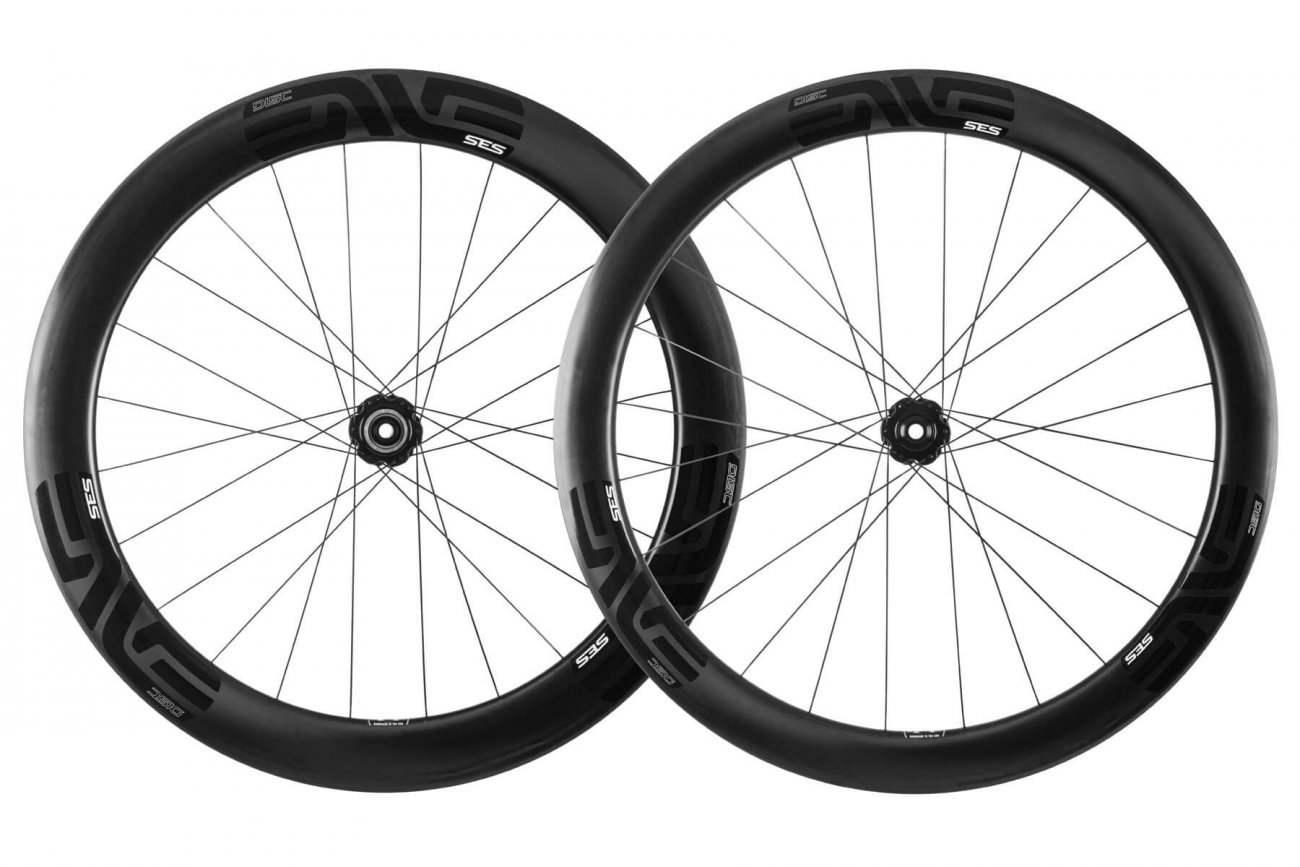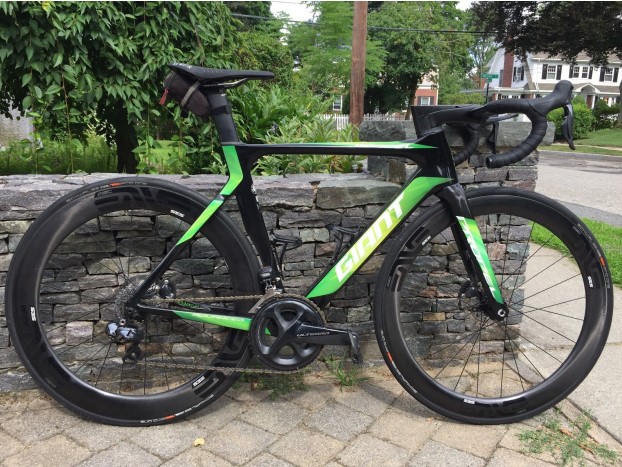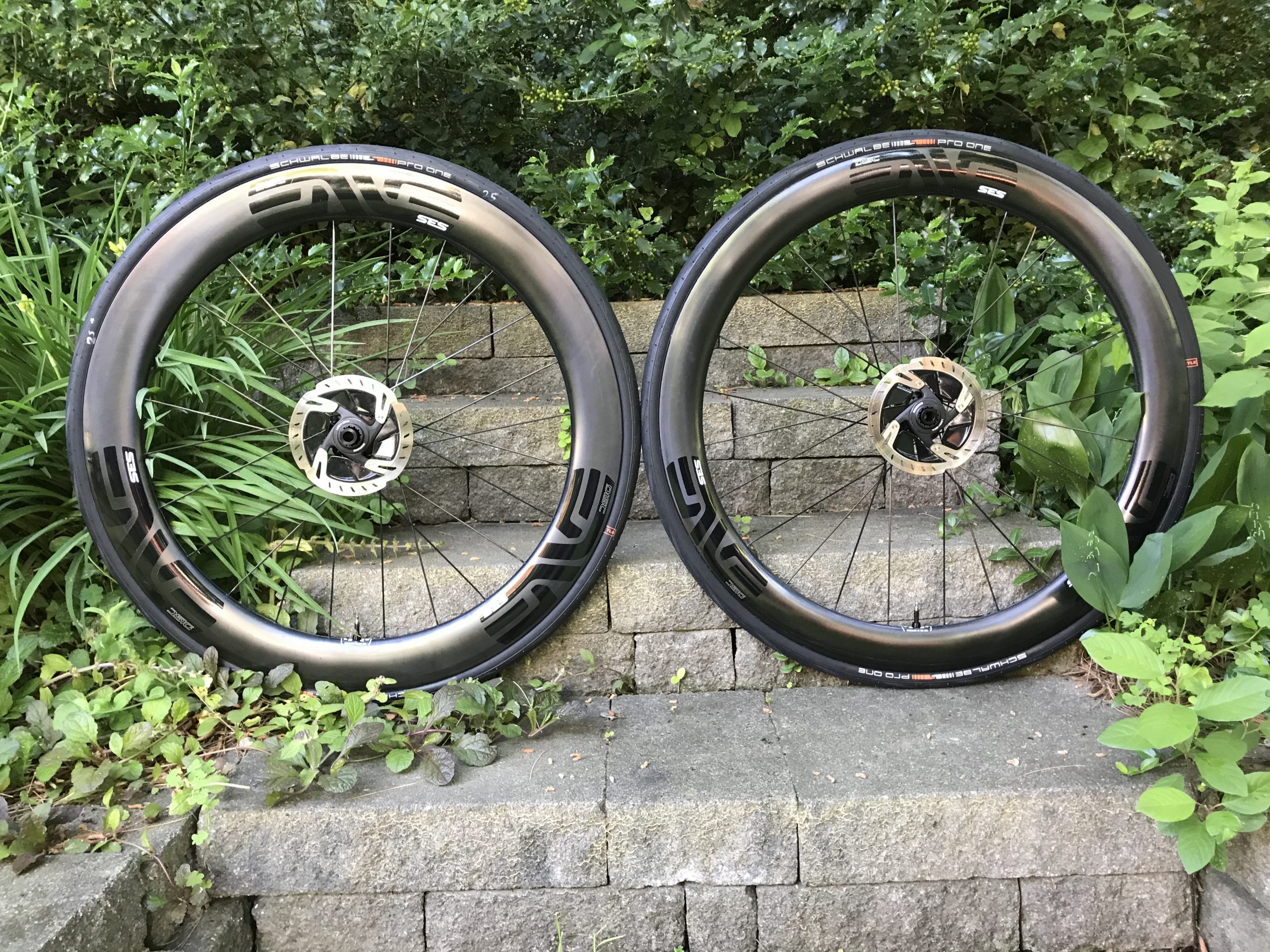ENVE 5.6 DISC – A STANDOUT DISC BRAKE WHEELSET

Note: With ENVE’s latest SES line-up, the SES 5.6 disc and rim brake models are no longer being manufactured. For similar performance characteristics, see my review of the SES 4.5 disc.
For a wheelset that was first introduced in 2016, the ENVE 5.6 disc still stands apart from the competition.
It’s not just the design characteristics that make it distinct, most notably the different front and rear rim depths, widths, and shapes. Rather, it’s the performance the design attempts to deliver that separates this wheelset on the road from others in the aero wheelset category with rims that go 55-65mm deep.
Click here to read reviews of other aero wheels
Conventional thinking about wheelsets (or at least the way I’ve always thought about them) is that there are low profile wheels, all-around wheels, aero wheels, and deep aero wheels.
All-around wheels, as the name suggests, should do a bit of everything. While not optimized for any single type of riding, the best are light enough for climbing, aero enough for fast riding, and stiff enough for quick acceleration. They are typically the best choice when you’ll be in the saddle for hours at a time riding a mix of flats, rollers, and climbs. Nimble, precise handling is a hallmark of all-around wheels and crosswinds are either not an issue or easily managed.
Conversely, aero wheels have typically been those we road cycling enthusiasts want when riding and maintaining speeds in the mid 20mph range (high 30kph range) is our priority above all else. While dedicated time trialists and triathletes might ride an 80mm or so deep aero wheelset or rear wheel, roadies go for 55-65mm aero wheels when most of what we ride is flat, straight, doesn’t involve a lot of big speed changes or accelerations, and lasts for no more than a couple of hours.
Good handling is a bonus for aero wheels. Since the rides are relatively short, comfort is nice but not a priority. Crosswinds and climbs are to be avoided.
Unique in our experience testing aero wheels, the ENVE 5.6 disc (and 5.6 rim brake model) rides almost like a blend of the best performance characteristics of wheelsets in both the all-around and aero categories. The parallel that comes to mind is what’s happening more recently with bikes that are combining an aero bike’s speed, road racing bike’s responsiveness, climbing bike’s weight, and endurance bike’s comfort into one bike that delivers all of that performance.
This ENVE 5.6 disc is as stiff as the best of the road disc wheels we’ve tested in the aero or all-around wheelset categories. Its responsiveness and acceleration are unmatched by most others in the aero test group and on par with the best in the all-around field.
While most aero wheels demand the kind of effort that convinces you to bring them up to speed gradually, you can sprint up these snappy ENVE 5.6 discs without feeling like you are burning through your limited number of matches.
These wheels also climb like champs, a level above other aero wheelsets we’ve reviewed and on par with the best all-around ones. Nate, my fellow tester with serious climbing palmares, noted this strength. Road racing tester Miles took it a step further saying they turned his Giant Propel aero bike into a capable climbing one going up a long, New Hampshire ascent that topped out at 14%.
The ENVE 5.6 disc handles as well as any of the aero wheels we’ve tested. Miles railed corners at high speeds with them and said he could often put in gaps to other riders during turns. He was also “totally confident diving these wheels into hairpin downhill turns.”
Though these wheels are easy to bring up to speed, holding that speed is one of the few places they are average compared to their deeper, heavier aero wheelset competitors.
Crosswinds are not an issue for the ENVE 5.6 disc. Their comfort is better than most, making 3-hour rides easy assuming your fitness also supports that long and fast a ride.
For those of us who take a close look at specs, this wheelset’s actual weight (1576g) stands out against other aero wheels with all but the Reynolds Aero65 DB (1611g) measuring between 75 and over 200 grams more. But, the Reynolds rims alone weigh 100 grams more than those on these ENVEs.
While the ENVE 5.6’s lighter weight may help you on climbs, that along with a 3-10mm shallower front wheel than others in the aero category may owe to it’s more average ability to maintain your speed. It’s not subpar but it’s also not up there with the best.
The finish on this wheelset and most ENVE wheels I’ve tested is a little disappointing. ENVE doesn’t paint their rims and the powdered curing agent they use in the resin can pool in spots near the surface of the rim during the molding process. When this happens, you’ll see some white markings when looking closely, typically along the spoke edge. They can become more pronounced over time.
It’s never been a big enough issue that I wouldn’t recommend ENVE wheels and I wouldn’t think it has any effect on their performance. ENVE replaced one set of wheels I bought where I thought the marks were particularly pronounced and they handled it professionally.
We tested the 5.6 disc with ENVE’s alloy hub, one that uses Mavic’s Instant Drive 360 internals. It’s a similar ratchet design to the DT Swiss 240 hub and engages well, spins smoothly, freehubs with a moderate amount of noise, requires next to no maintenance, and at $2550, is the lowest-priced option. ENVE also offers these wheels with Chris King R45 alloy and ceramic bearing hubs or I9 Torch ones, all of which make the wheelset marginally heavier and significantly more expensive than with the ENVE hub.
If you’re looking for a wheelset to help you in time trials, flat crits, or flat solo and group rides, a more traditional design aero wheelset may be better for you. But if you are an enthusiast who wants to ride fast all day, spinning up quickly from a variety of speeds, on all grades of terrain, handling precisely through corners and switchbacks, the ENVE 5.6 disc stands alone in being able to do all of that.
In The Know Cycling is ad-free, subscription-free, and reader-supported. If you want to help keep it rolling without any added cost to you, buy your gear and kit after clicking the store links on the site. When you do, we may earn an affiliate commission that will help me cover the expenses to create and publish our independent, comprehensive, and comparative reviews. Thank you, Steve. Learn more.



Thanks for this, Steve.
The above certainly positions the 5.6 as the ultimate all around wheelset. What type of riding would you recommend the 4.5 AR’s over these for?
I’m 68kg and ride on flat and rolling roads in the UK. Surfaces are varied from smooth to potholes and a bit of road debris. Hills can be punchy at 15-20% but only for, say 6-10 mins. I don’t race and riding is club and small groups.
I’d welcome your thoughts. Thanks in advance!
Charles, the 4.5 AR is the all-road all-around. So in addition to paved road riding, if you were looking for one wheelset to also do a fair amount of off-road dirt riding and cyclocross at good speeds, I’d go for the 4.5 AR. You could put on a cross or gravel tire on those wider rims. You’d want to use the 5.6 disc for paved roads exclusively. The occasional pothole or road debris shouldn’t be any more of an issue on the 5.6 vs any other wheelset. Best with tubeless tires though. Steve
Steve, From the pics, looks like you were running Schwalbe Pro Ones……25mm?
DMac, Yes. We’ve also been riding them with the new 25c ENVE SES tubeless tires of late. Even better fit. See my social media post from a couple weeks ago for pics and rim-tire ratios. Steve
I bet the new Roval Rapide 50 mm front and 60 mm rear would be a close match to these wheels. I just got a set on my new Roubaix expert and they are great. The spin up very quickly. They are more than 100 grams lighter. They handle great.
I know you commented on the new Roval CLX Rapide elsewhere, but now that I am riding them I feel that the description would be similar to those of the ENVE 5.6 (which I have not ridden). A few differences are worth noting however. In fact, I was down to the 5.6 vs the CLX when deciding what to buy.
The CLX has bucked the trend on tubeless – which will rule them out for many, but in exchange you get wheels that are 1400g claimed weight. Since I am not sold on tubeless for my road bike the weight savings was notable.
They use DT240 EXP internals vs the DT350 in the 5.6. Great warranty also.
Be advised, they are VERY wide in front at 35mm, so some frames might not support them.
I have been struck by how comfortable they are, even compared with my low profile alloy training wheels. Spin up is very fast. We don’t have any mountains south of Atlanta so I cannot comment on how they are from that point of view, but on the short steeps I don’t feel any disadvantage likely due to the low weight.
I ride them on a SL6 Tarmac (Ultegra Di2) if anyone wants to know.
John, Thanks for your input on the CLX Rapide. Sounds like you are having a great time riding them. Cool! One correction. The ENVE 5.6 disc doesn’t use the DT 350 but rather gives you the choice of the ENVE Alloy hub with Mavic ID 360 ratchet freehub internals, Chris King or Industry Nine brand hubs. Steve
I misread the Mavic 360 as 350 (thinking DTSwiss). My apologies.
Thanks for the comparison as these are the two I’m considering on my Tarmac SL6. Do you mind me asking your weight and what tires you are using? Thank you!
One thing I will mention is that the front wheels are 18 spoke on the Rapide vs. 24 spoke on the Enve 5.6. I’m a heavier rider that loves to bomb twisty mountain decents so I’m leaning towards the Enves as I’ve heard comments of brake modulation on the fronts of the Rapide due to the spoke flex from the lower spoke count. I’m curious if you’ve experienced this. Thanks again!
Hi John, what tires and width are you running on the Roval Rapides? Do you have a way to measure the inflated width of the tires? I am curious as I have been looking at both these sets of wheels. With the Rovals being newer, its been difficult finding many people with them.
Hi Steve,
I remember you saying you like quiet hubs. If you were building the Enve’s, which ones would you use to achieve that goal assuming all 3 available are reasonably close in weight and performance?
Corky, The ENVE Alloy hubs are far quieter than the Chris King and i9. They are marginally lighter too. Steve
Hi Steve,
Do you think that tubed tire on SES 5.6 keep same performance and comfort as tubless one?
Eric, In general, the best everyday tubeless tires will provide lower rolling resistance and therefore be faster than the best clincher tires. You can, however, use a latex tube in a tubeless tire and get nearly the same rolling resistance as using a sealant in place of a tube. Using tubeless tires with sealan allows you to inflate your tires to a lower recommended pressure than with a tube inside a tubeless or clincher tire. A lower tire pressure gives you both more comfort and better handling performance. All of this applies regardless of the wheelset, assuming it is tubeless-ready. Steve
from the sound of things, these wheels are incredibly versatile, even rivaling most all-around wheelsets. This leaves me in a toss up between these and the zipp 303 firecrest. Ignoring that they are in different price classes there is some overlap in their performance and capability, so I what would your verdict be between the two? Compairing the performance, handling, and ‘free-speed’ would a rider be better served by the versitile aero wheel in the 5.6, or the fast all around wheel in the 303?
Hi Marcus, On performance alone, I’d only recommend the 303 Firecrest Disc over the ENVE 5.6 disc if you were looking for a dedicated climbing wheelset, wanted to use one wheelset for both road and gravel, or if you prioritize comfort (and wide tires) over speed. Other than on rough roads where you’d want the Firecrest, I wouldn’t say one handles better than the other. Steve
Steve – How do the 5.6 wheels compare to zipp 454 NSW tubeless wheels for rides?
Thanks so much!
Christian, Had an exchange on just this topic in the comments of the 454 review. Take a look at the thread starting with Justin’s question on Sept 11, 2021 here: https://intheknowcycling.com/zipp-454-nsw-review-zipp-353-nsw-review/#comments
Hi Steve, you say these are average in performance when ‘at speed’ compared to other brands. Why is that, are the sluggish in maintaining momentum, are the bearings / hubs not as good, ….
How do they compare against say Zipp 404’s?
Brad, They are far from “sluggish” and their hubs are quite good. It’s just that some other aero wheelsets that have an 8-10mm deeper front wheel hold their momentum better. They are a bit stiffer, more compliant, and climb better than the 404 but hold their speed equally well. The 404 is a better value. See the aero wheelset review for a complete comparison. Steve
Great review,thanks, I’m possibly upgrading on a set of 2end Enve, and have found 5.6 ses disc with the dt Swiss 240 and another set with the Enve alloy hub for 200 extra euros. What would you recommend if the wheels are in the same conditions? Many thanks. Davide
Davide, Both hubs are fine but ENVE hasn’t made those wheels with DT Swiss 240 hubs for 3 or 4 years so I’d wonder what else might be different about them. I’d actually pass on both of those wheels and go with the newer, faster and more comfortable ENVE SES 4.5. Steve
Thank you very much
Hi Steve, Would you say the CK hubs are worth the premium over the standard Enve alloy hubs?
No. You get a unique freehub sound but no better performance.
Hi Steve
What would you think of using Enve 65 front wheel and 5.6 rear wheel?
Would that potentially improve frontal aerodynamics with deeper wheel whilst maintaining the other benefits of 5,6 wheelset rear wheel?
Nah. You’re overthinking it. Optimize what you have and spend more time in your aero position.